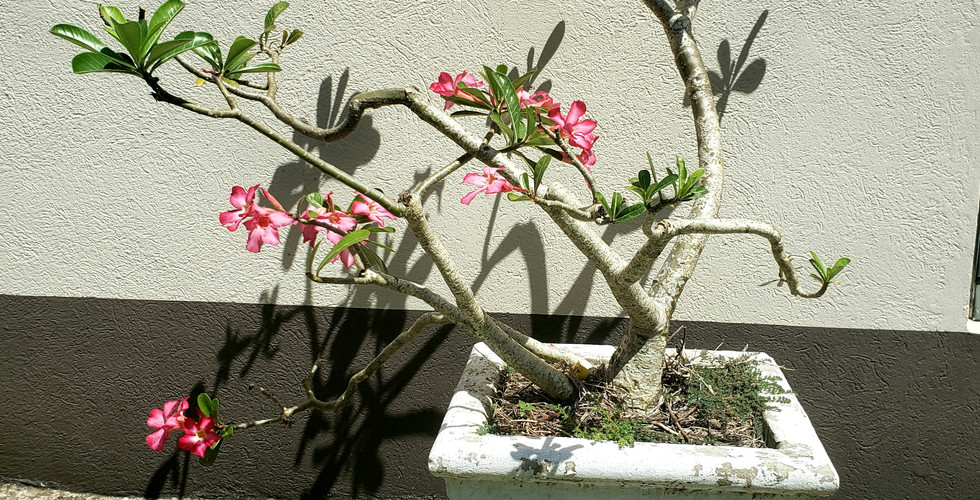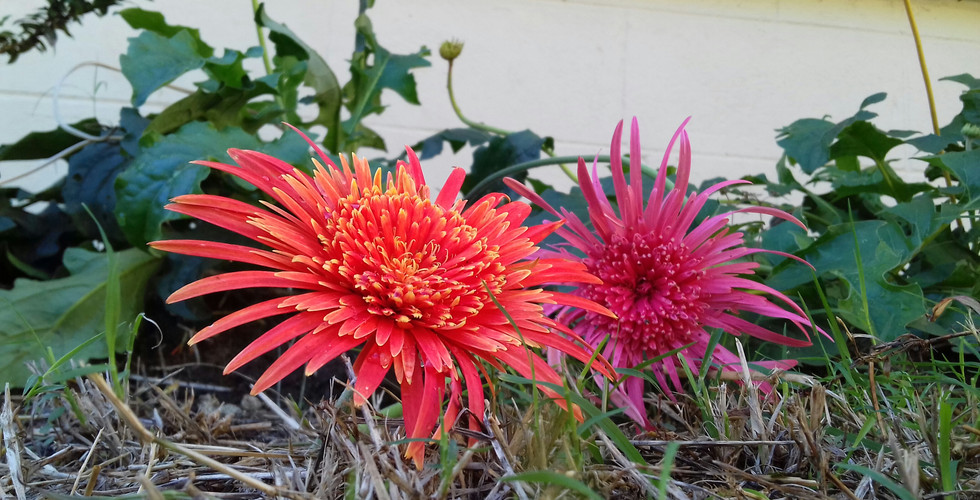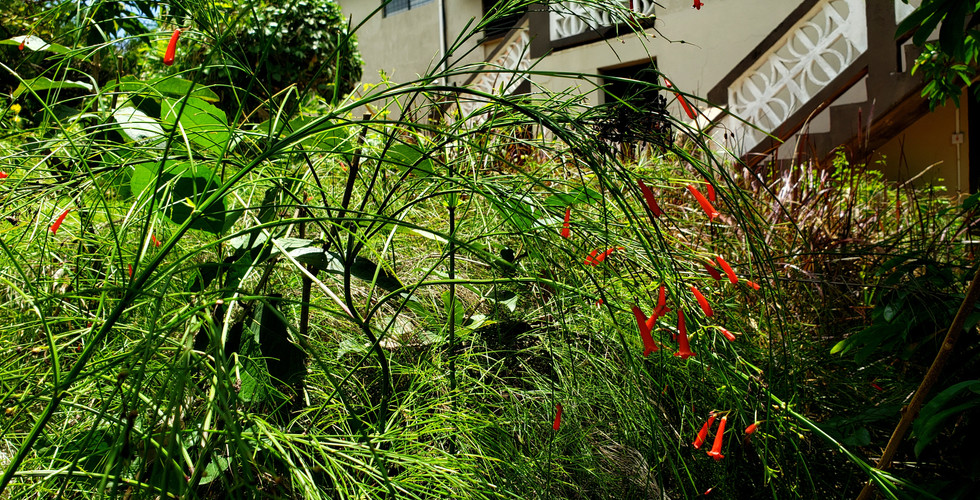Top Ten Slug, Snail and Drought Resistant Tropical Ornamental Plants
- boycemartin
- Sep 14, 2021
- 4 min read
Updated: Aug 3, 2022
Although I’ve been more interested in food plants, because I manage a property, through trial and error, I’ve chosen these as my top ten ornamental plants which, once established, are best suited to a low maintenance regime, surviving an increasingly severe dry season in Barbados. They have the added advantage of being unappealing to slugs and snails, even when there are no other plants for them to decorate with their slime, and gourmandise. (I include Wikipedia links in the titles).
Returning to Barbados, I realised everybody and duh granmudduh had a desert rose. With the water shortages it became clear why (it’s in the name). You’re more likely to kill this plant by giving it too much water. Diffierentiate yourself “by de hook or de crook” with a black one:

Trim branches to the Y’s, just before the rains (June in Barbados) unless you like them artsy (scraggly – top photo 1 versus photo 3).

Tip: Knick the seed with a knife and soak it over night and it’ll surprise you how fast it breaks the soil’s surface. You’ll have to decide to allow it to grow into a tree or to prune it so it becomes a voluminous Carmen Miranda drag queen plant.
Pride of Barbados 🇧🇧 cultivar blowing in the wind (Wait boah! That’s actually Carmen Miranda)
Gerbers look like something I’d eat if I were a slug, however, they don’t even point their eye stalks at them. Gerbers die down during the dry season, but, just when you’ve forgotten you’d planted them next to the ixora, they shout, “LOOK MUH HEY!” at the next rains.
If you can’t grow grass, give up gardening and try learning how to boil water.

Christmas 🌴
There are so many varieties (follow title link). Associated with elegant hotels and Barbadian West Coast villas, you may need to belt them with sheet metal to discourage rats from climbing them to nest, or to eat their fruit since, economically, the rats also seem to have fallen on tough times due to the pandemic.

Golden 🌴

Foxtail 🌴
[WATCH OUT] Host plant for Catopsilia pyranthe (Mottled Emigrant) and Eurema hecabe (Common Grass Yellow), a white and a yellow (duh) butterfly, respectively (nothing to do with the click bait stink bug on my finger above).
THEM BUTTERFLIES DOES MAKE ME SING MY SOUL because they give this plant’s soft, young leaves egg laying preference, and I am OCD about leaves made imperfect by ravenous caterpillars.
IT DOES BE WAAAR!
This anthem plays whenever I see butterflies in my garden, especially this part: “Me rise up me guns, bombs, grenades, anthrax, cyanide and c4, What you wanna war wid me for?”
So probably swap this one out for Allamanda (below) unless you can’t give up the unique infloresences that indicate it is time to not buy anyone a Christmas gift because I don’t subscribe to Capitalist consumerism or buying gifts with money I don’t have DURING A PANDEMIC. You could also immitate me and remove the butterfly eggs, although the cyclical nature of the butterfly-Allamanda relationship means the plant isn’t always being eaten beyond what it can bare (as if tested by the Lord).

Neoregelia spectabilis commonly called ‘fingernail’ bromeliad (I call it ‘slutty Steven’)
Bromeliads tend to prefer filtered light, but there are a few that have gained popularity in Barbados because of their ability to tolerate full sun like the green ones that turn yellow-orange (Aechmea blanchetiana ‘Orange’):

Or the one I have that goes purple (Aechmea ‘malva‘) while screaming “WHAT HAVE YOU DONE TO THE ATMOSPHERE HUMANS?!” as the sun seems to draw closer to the Earth. (It may be hotter, but they breathe so much better now).



I thought the flowers used animals (including humans) for seed dispersal, but it seems the sepals are very sticky in order to trap food, and it may be one of the first carnivorous plants. So, before you know it, you’ve disappeared, last seen watering the garden. (Some of you might be delighted to know the flowers are bisexual, others may still speak vehemently of what is considered “natural“).
9. Cacti


African snails don’t have no conscience so, regarding cacti, go for the thornier ones with their succulent parts covered (same applies if I’m the African snail, you remove the ‘t’ and speak of sexual partners).
In full sun, this will keep fountaining red sparks (or, there’s a yellow variety) and it gets so thick you’ll have no hope of finding what you dropped in it *whispering* I dropped my cousin in it.
Three Alternatives

Mollusks seem to avoid eating plants that produce the white latex this one oozes when injured. SOME SPECIES (don’t go telling nobody I say eat this plant!) are being studied for their potential medicinal properties, including their effects on cancer and HIV.
Once this one is acclimatized, it is like me let-go in Lava Ground nightclub in the 90s though, so make sure you plant it where you want it (unless you like latex in your eye), and also be mindful…I heard it – especially the vine variety – likes to push down fences.
Pretty for days (albeit a little too 1980s for discerning tastes).
Tends to suffer iron deficiency indicated through chlorosis (leaf yellowing). Get it a good multivitamin from your favourite plant pharmacist.
Check out more posts about my plant life.







































Comments